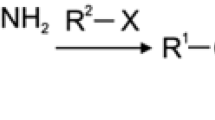Abstract
The vasodilator effects of C92-4609 (4-hydroxymethyl-furoxan-3-carboxamide, CAS 1609), C92-4678(4-phenyl-furoxan-3-carboxylic acid (pyridyl-3-yl-methyl)-amide), C92-4679 (3-phenyl-furoxan4-carboxylic acid (pyridyl-3-yl-methyl)-amide) and C93-4759 (3-hydroxymethyl-furoxan-4-carboxamide) were studied in the isolated rabbit femoral artery and jugular vein. All furoxans were potent vasodilators in the femoral artery (EC50 0.1–50 μM), while they were less potent in the jugular vein by at least one order of magnitude. Apart from C92-4679, the vasodilatory potency of the furoxans correlated well with their nitric oxide (NO)-releasing capacity which was estimated both by stimulation of purified soluble guanylyl cyclase activity and electron spin resonance spectroscopy with a trapping agent for NO. The hypothesis that furoxans stimulate soluble guanylyl cyclase in the smooth muscle by spontaneously releasing NO was supported by the marked attenuation of their vasodilator effect in the presence of oxyhaemoglobin (10 μM) or following treatment with methylene blue (30 μM). In contrast to earlier findings, NO release from these furoxans was not thiol-dependent, as demonstrated for C92-4609, the relaxant effect of which in the femoral artery was not altered in the presence of N-acetyl-l-cysteine (1 MM).
Moreover the K sup+infCa channel inhibitor, tetrabutylammonium (3 mM), but not the K sup+infATP channel inhibitor, glibenclamide (3 μM), significantly attenuated the dilator response to C92-4679 in the femoral artery. Pretreatment of these segments with the cytochrome P450 inhibitor, SKF525a (30 μM), also reduced the C92-4679-induced relaxation in this vascular bed. The vasorelaxant activity of C92-4679 thus appears to be based both on the spontaneous release of NO2 which is accelerated due to biotransformation within the vessel wall, and a direct interaction with K+ Ca channels in the smooth muscle.
In the rabbit jugular vein, the dilator response to C92-4609 was not affected following exposure to glyceryl trinitrate (1 mM) for 1 hour or pretreatment with the same concentration of C92-4609 or its isomer, C93-4759. This lack of tolerance development together with their pharmacological potency may render the new generation of furoxans useful drugs in the treatment of coronary heart disease.
Similar content being viewed by others
References
Abrams J (1991) Clinical aspects of nitrate tolerance. Eur Heart J 12 [Suppl E]:42–52
Abrams J (1992) Mechanism of action of the organic nitrates in the treatment of myocardial ischemia. Am J Cardiol 70: 30B–42B
Archer SL, Huang JMC, Hampl V, Nelson DP, Shultz PJ, Weir EK (1994) Nitric Oxide and cGMP cause vasorelaxation by activation of a charybdotoxin-sensitive K channel by cGMP-dependent protein kinase. Proc Natl Acad Sci USA 91:7583–7587
Bennett BM, Schröder H, Hayward LD, Waldman SA, Murad F (1988) Effect of in vitro organic nitrate tolerance on relaxation, cyclic GMP accumulation, and guanylate cyclase activation by glyceryl trinitrate and the enantiomers of isoidide dinitrate. Circ Res 63:693–701
Bennett BM, McDonald BJ, Nigam R, Simon WC (1994) Biotransformation of organic nitrates and vascular smooth muscle cell function. Trends Pharmacol Sci 15:245–249
Bolotina VM, Najibi S, Palacino JJ, Pagano PJ, Cohen RA (1994) Nitric oxide directly activates calcium-dependent potassium channels in vascular smooth muscle. Nature 368:850–853
Calvino R, Fruttero R, Ghigo D, Bosia A, Pescamona GP, Gasco A (1992) 4-Methyl-3-(arylsulfony)furoxans: A new class of potent inhibitors of platelet aggregation. J Med Chem 35:3296–3300
Cohn JN (1992) Pharmacologic mechanisms of nitrates in myocardial ischemia. Am J Cardiol 70:38G–42G
Elkayam U, Mehra A, Shotan A, Ostrzega E (1992) Nitrate resistance and tolerance: Potential limitations in the treatment of congestive heart failure. Am J Cardiol 70:98B–104B
Feelisch M, Schönafinger K, Noack E (1992) Thiol-mediated generation accounts for the vasodilator action of furoxans. Biochem Pharmacol 44:1149–1157
Flaherty JT (1992) Role of nitrates in acute myocardial infarction. Am J Cardiol 70:73B–81B
Fung, HL, Chung SJ, Bauer JA, Chong, Kowaluk EA (1992) Biochemical mechanism of organic nitrate action. Am J Cardiol 70:4B–10B
Gosh PB, Everitt BJ (1974) Furazanobenzofuran, furazanobenzothiadiazole and their N-oxides. A new class of vasodilator drugs. J Med Chem 117:203–206
Harrison DG, Bates JN (1993) The nitrovasodilators. New ideas about old drugs. Circulation 87:1461–1467
Horowitz JD (1992) Role of nitrates in unstable angina pectoris. Am J Cardiol 70:64B–71B
Keith RA, Burkman AM, Sokoloski TD, Fertel RH (1982) Vascular tolerance to nitroglycerine and cyclic GMP generation in rat aortic smooth muscle. J Pharmacol Exp Ther 221:525–531
Loscalzo J (1992) Antiplatelet and antithrombotic effects of organic nitrates. Am J Cardiol 70:18B–22B
Martin W, Villani GM, Jothianandan D, Furchgott RF (1985) Selective blockade of endothelium-dependent and glyceryl trinitrate-induced relaxation by hemoglobin and by methylene blue in the rabbit aorta. J Pharmacol Exp Ther 232:708–716
Meisheri KD, Cipkus-Dubray LA, Hosner JM, Khan SA (1991) Nicorandil-induced vasorelaxation: Functional evidence for K+ channel-dependent and cyclic GMP-dependent components in a single vascular preparation. J Cardiovasc Pharmacol 17:903–912
Mülsch A, Hecker M, Mordvintcev P, Vanin A, Busse R (1993) Enzymic and nonenzymic release of NO accounts for the vasodilator activity of the metabolites of CAS 936, a novel long-acting sydnonimine derivative. Naunyn-Schmiedeberg's Arch Pharmacol 347:92–100
Pinto A, Abraham NG, Mullane KM (1987) Arachidonic acidinduced endothelial-dependent relaxations of canine coronary arteries: Contribution of a cytochrome P450-dependent pathway. J Pharmacol Exp Ther 240:856–863
Thadani U (1992) Role of nitrates in angina pectoris. Am J Cardiol 70:43B–53B
Author information
Authors and Affiliations
Rights and permissions
About this article
Cite this article
Hecker, M., Vorhoff, W., Bara, A.T. et al. Characterization of furoxans as a new class of tolerance-resistant nitrovasodilators. Naunyn-Schmiedeberg's Arch Pharmacol 351, 426–432 (1995). https://doi.org/10.1007/BF00169084
Received:
Accepted:
Issue Date:
DOI: https://doi.org/10.1007/BF00169084




